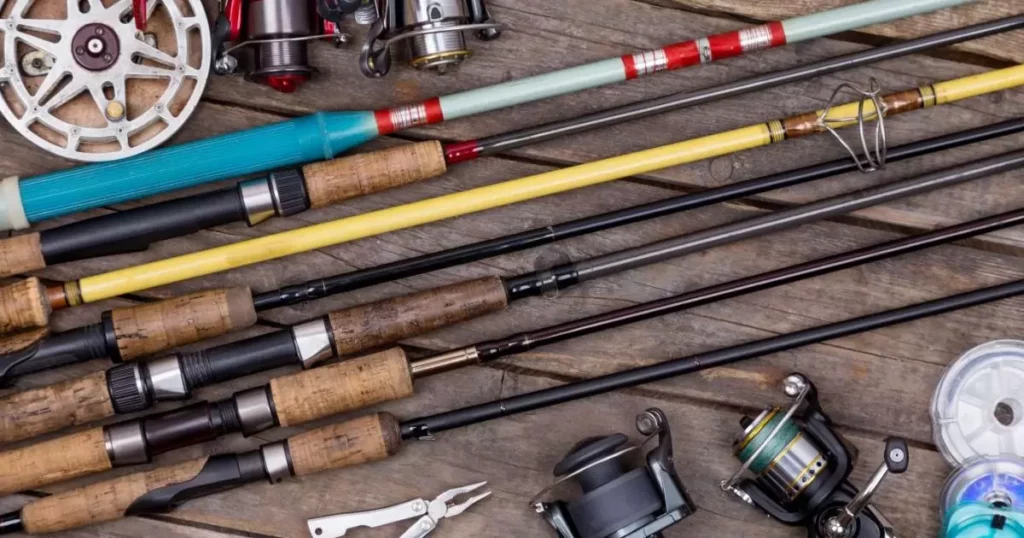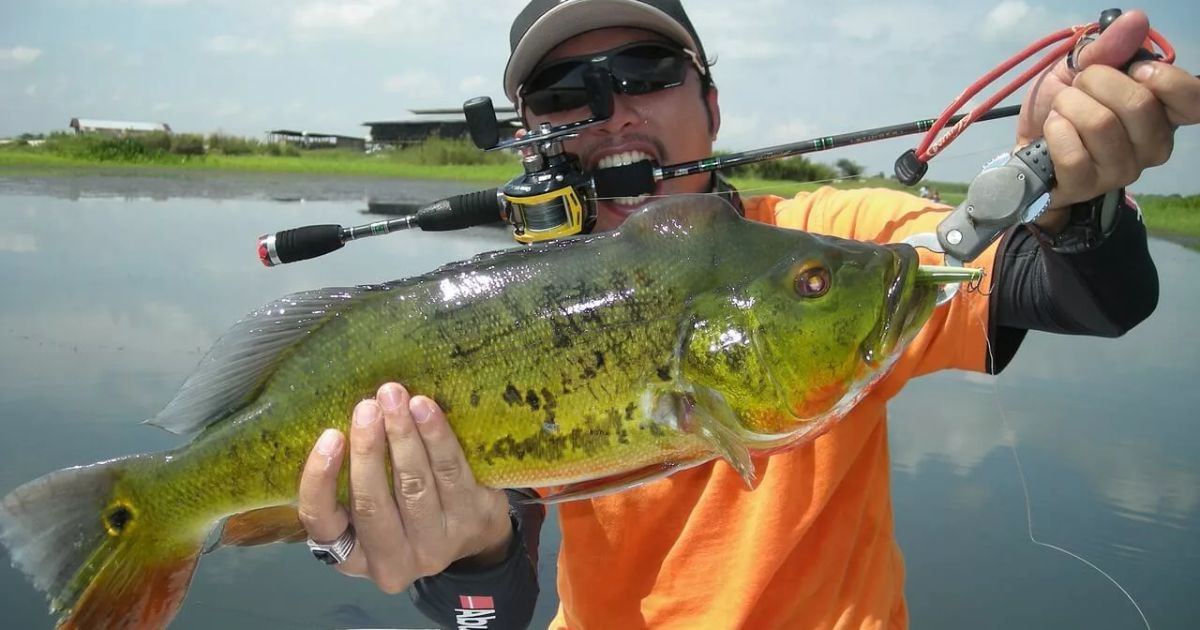The size of a reel for bass fishing refers to its physical dimensions and line capacity, tailored to the needs of angling for bass. It should accommodate the preferred fishing line weight and length while providing the necessary power and control to handle the bass, balancing factors like line capacity, gear ratio, and drag system for a successful fishing experience.
Selecting the appropriate fishing gear is crucial for a successful bass fishing expedition. A key question often asked is, What size reel for bass fishing? The size of your reel plays a pivotal role in your angling experience. Bass, known for their strong and unpredictable fights, require a reel that can handle the stress.
Factors to consider include line capacity, gear ratio, and the reel’s drag system. Opting for a reel with the right line capacity ensures you can accommodate the preferred fishing line weight and length. A suitable gear ratio allows for effective lure retrieval, while a robust drag system ensures you have the control needed to land those elusive basses. In the end, the choice of reel size significantly impacts your bass fishing success.
The Basics of Bass Fishing Reels
Before we dive into the specific sizes of bass fishing reels, let’s start with the basics. A fishing reel is a mechanical device used to store, release, and retrieve fishing lines. In the context of bass fishing, you’ll find three main types of reels: baitcasting reels, spinning reels, and spin-cast reels. Each has its own advantages and is used in different situations, but reel size remains a crucial factor regardless of the type.
Understanding the Reel Size
Bass fishing reels come in various sizes, and these sizes are typically categorized numerically. The numbers represent the size of the reel and are not consistent across different. manufacturers. So, a “2000” size reel from one brand might differ in dimensions and capacity from a “2000” size reel from another brand. Therefore, understanding the relative size within a manufacturer’s lineup is key.
Factors to Consider When Choosing the Right Reel Size
When choosing the right reel size for your bass fishing needs, several factors come into play. These include line capacity, fishing technique, target species, and lure weight. Line capacity should match your preferred line strength, and the reel’s size should align with your fishing technique, whether finesse or heavy-duty. Considering the potential for encountering different species and the weight of your lures will help you make an informed decision.
Line Capacity
The line capacity of a reel is essential. For bass fishing, you’ll typically be using line in the range of 6 to 20-pound tests. A reel’s line capacity should comfortably accommodate the line you intend to use. Having sufficient line capacity is crucial when targeting larger bass or when fishing in waters with heavy cover.
Fishing Technique
The technique you plan to use also plays a role in reel size selection. Baitcasting reels are popular for techniques that require precision, such as flipping and pitching, while spinning reels are versatile and suitable for various techniques like finesse fishing and drop shooting. The size of the reel must match the type of fishing you intend to do.
Target Species
While you’re primarily targeting bass, consider the potential for encountering other species in the same waters. If you anticipate the possibility of hooking into larger fish like catfish or pike, you may want a reel with a larger size and greater line capacity.
Lure Weight
The weight of the lures you intend to use can also influence reel size. Smaller lures are easier to cast with smaller reels, while larger lures might require the additional power and line capacity provided by a larger reel.
Reel Types and Their Appropriate Sizes

Reel types in bass fishing, such as baitcasting and spinning reels, come in various sizes to suit specific techniques and preferences. Smaller baitcasting reels offer precision for finesse methods, while medium-sized ones provide versatility. Larger baitcasting reels excel in heavy-duty applications. Spinning reels range from ultralight to large sizes, each catering to different angling styles. Your choice of reel size greatly impacts your success on the water.
Baitcasting Reels
Baitcasting reels are precision tools highly favored by anglers for their accuracy and control. They excel in various bass fishing techniques, from flipping and pitching to handling heavier lines and lures. Their adjustable braking systems provide anglers with fine-tuned control, making them ideal for both beginners and experienced fishermen. Selecting the right size for a baitcasting reel, you should consider the following.
Lighter models (100-200 sizes) These smaller baitcasting reels are ideal for finesse fishing and techniques where precision casting is crucial. They work well with lighter lines and smaller lures.
Medium-sized models (200-300 sizes) Medium-sized baitcasting reels are versatile and can handle a wide range of techniques. They are well-suited for spinnerbaits, crankbaits, and jigs. They provide a balance between control and line capacity.
Larger models (300+ sizes) Bigger baitcasting reels are designed for heavy-duty applications, such as flipping, pitching, or fishing in heavy cover. They offer the necessary line capacity and power to handle larger fish.
Spinning Reels
Spinning reels are versatile and popular among anglers for their ease of use. They feature an open-face design, making them suitable for various fishing techniques. Spinning reels excel in casting lightweight lures and offer smooth line retrieval. Their user-friendly nature makes them a great choice for both beginners and experienced anglers. Here’s what you need to know about selecting the right size for a spinning reel.
Ultralight to small sizes (1000-2500) Ultralight and small spinning reels are great for finesse fishing with light lines and small lures. They are suitable for techniques like drop shooting and wacky rigging.
Medium sizes (3000-4000) Medium-sized spinning reels are the most versatile and can handle a wide range of bass fishing techniques. They provide a good balance between line capacity and casting ability.
Large sizes (5000+) Large spinning reels are used for heavy-duty applications and are designed to handle larger fish and heavy cover. They are suitable for techniques like frogging and swimbait fishing.
Spincast Reels
Spincast reels are relatively straightforward and easy to use, making them a good choice for beginners. However, they are not as popular among serious bass anglers, primarily due to their limited line capacity and casting distance. Spincast reel sizes are generally not specified in the same numerical format as baitcasting and spinning reels, but they typically come in sizes like small, medium, and large.
A Note on Brand Variations
It’s important to mention that the sizing of reels can vary from one manufacturer to another. While the numerical size serves as a general reference, it’s essential to consult the manufacturer’s specifications for precise details. This is because the dimensions and capacities can differ significantly between brands and models.
Personal Preferences
Selecting the right reel size is also influenced by personal preferences. Some anglers may prefer smaller, more compact reels for their lightweight and maneuverability, while others may opt for larger reels to ensure they have ample line capacity and power when needed. Experimenting with different sizes and styles can help you discover what works best for your specific needs.
Maintaining Your Reel
Once you’ve selected the appropriate reel size for your bass fishing needs, it’s crucial to maintain your equipment properly. Regular cleaning and maintenance of your reel will ensure it functions optimally, lasts longer, and provides a smooth fishing experience. Additionally, proper care can extend the life of your reel, saving you money in the long run.
FAQs
What size reel should I use for bass fishing?
The reel size depends on factors like your fishing technique and target species. Smaller reels are great for finesse fishing, while larger ones handle heavy cover and larger bass.
How does reel size affect my casting distance?
A smaller reel may limit casting distance, while larger ones can cast farther, but it’s not the only factor at play.
Is there a universal reel size for bass fishing?
No, reel sizing varies among manufacturers, so consider each model’s specifications carefully.
What happens if I choose the wrong reel size for bass fishing?
Selecting the wrong reel size may lead to casting issues, limited line capacity, and reduced performance.
Are there personal preferences when it comes to reel size?
Yes, personal preferences play a role in reel size selection. Some anglers prefer compact reels, while others prioritize line capacity and power.
Conclusion
Choosing what size reel for bass fishing? is a critical step in ensuring a successful and enjoyable fishing experience. Consider factors such as line capacity, fishing technique, target species, and lure weight when selecting the size of your reel. Remember that different reel types offer distinct advantages and are suited to various fishing scenarios. Personal preferences also play a significant role in reel size selection.
The key to finding the perfect reel size for your bass fishing adventures is experimentation and a deep understanding of your angling needs. By taking these factors into account and staying informed about the latest developments in reel technology, you can make an educated choice that enhances your bass fishing endeavors and ensures memorable days on the water.

